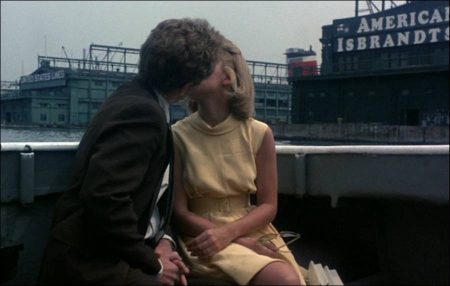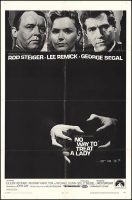Taglines: …or is it?
No Way to Treat a Lady movie storyline. Christopher Gill is a psychotic killer who uses various disguises to trick and strangle his victims. Moe Brummel is a single and harassed New York City police detective who starts to get phone calls from the strangler and builds a strange alliance as a result. Kate Palmer is a swinging, hip tour guide who witnesses the strangler leaving her dead neighbor’s apartment and sets her sights on the detective. Moe’s live-in mother wishes her son would be a successful Jewish doctor like his big brother.
No Way to Treat a Lady is a 1968 black comedy thriller directed by Jack Smight, with a screenplay by John Gay adapted from William Goldman’s novel of the same name. The film starred Rod Steiger, Lee Remick, George Segal and Eileen Heckart. Segal was nominated for a BAFTA for his role as Detective Moe Brummel.
About the Story
Christopher Gill (Rod Steiger) is a serial killer fixated on his late mother, a noted stage actress. Gill preys on older women. A Broadway theatre owner and director, he adopts various disguises, e.g., priest, policeman, plumber, hairdresser, etc., to put his victims at ease (and avoid being identified) before strangling them and painting a pair of lips on their foreheads with garish red lipstick.
Detective Morris Brummell (George Segal) is investigating the murders. Brummel is quoted in the newspaper that the latest murder was well-planned and well-executed. This appeals to Gill’s ego, so he starts telephoning Brummel to chat about the murders and the state of the investigation. Brummel is able to elicit a few scraps of information about Gill, but for the most part Gill succeeds in taunting him without giving away his identity.
Away from work, Brummel’s own overbearing mother (Eileen Heckart) wants her son to be more like his doctor brother and settle down. She is scornful of his career choice. Brummell’s new love interest is Kate Palmer (Lee Remick), who glimpsed Gill minutes before he committed the first murder, though not well enough to identify him in a way that would aid the investigation. She manages to win over Brummell’s mother by claiming she is planning to become Jewish, and by pretending to dominate her son.
In what turns out to be their last phone conversation, Brummel turns the tables on Gill and insults him. Gill subsequently targets Kate. This is obviously for reasons other than his mother fixation, as Palmer does not fit the profile of his previous victims. He may be jealous of Kate, or perhaps wants revenge on Brummell for the insults.
Gill attacks Kate in her apartment, but is forced to flee before he can do her serious harm. During the police manhunt that follows, Gill is seen entering his theatre via a side door. Investigating the sighting, Brummell chats amiably with Gill (the detective at that point cannot be sure the man before him is Kate’s attacker). When he sees in the theatre lobby a painting of an actress with her lips highlighted in deep red lipstick, which Gill volunteers is a portrait of his mother, he knows he has his man.
No Way to Treat a Lady (1968)
Directed by: Jack Smight
Starring: Rod Steiger, Lee Remick, George Segal, Eileen Heckart, Murray Hamilton, Michael Dunn, Martine Bartlett, Barbara Baxley, Irene Dailey, Doris Roberts, Ruth White, Val Bisoglio
Screenplay by: John Gay
Cinematography by: Jack Priestley
Film Editing by: Archie Marshek
Set Decoration by: George Jenkins
Art Direction by: George Jenkins
Music by: Andrew Belling, Stanley Myers
MPAA Rating: None.
Distributed by: Paramount Pictures
Release Date: March 20, 1968
Views: 194


